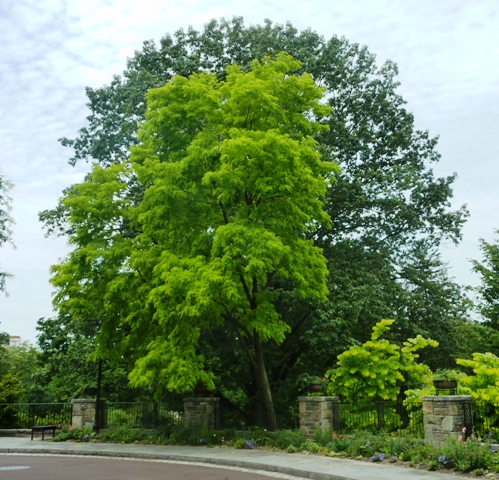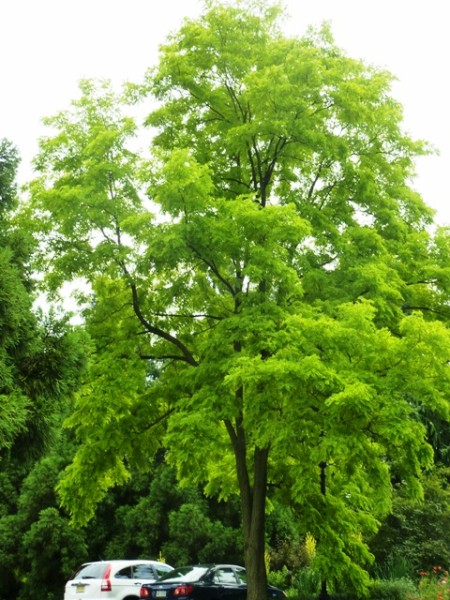Several years ago I wrote an article titled ‘ Why I Won’t Plant Robinia pseudoacacia ‘Frisia‘ again : A Love Affair Gone Awry.
It was about how I fell in love with a Golden locust some 2o plus years ago when I first saw it in London.
How I knew I was going to find a place in my garden for it at the right time and was able to do so after a major renovation.
How I was swept away by my vision of what the end result would be.
How I knew that the benefits of Robinia pseudoacacia ‘Frisia‘ would be numerous. Within a year after buying these 2-3’ tall leafless sticks from Gosslers Farms Nursery, the first 3 Robinias had become stars of the garden.
What started out as 3 Robinia pseudoacacia ‘Frisia’ on the top level of my garden, within a few years grew to 6, and then 9 .
The shortcut version of the story is that after 5 years of marveling at their early spring green ovate leaves, followed by fragrant white pea like flowers, the chartreuse/yellow foliage in summer, then a vibrant yellow into the fall before dropping their leaves, the Golden locusts had become problematic.
I ended the article by saying that I absolutely would not use Robinia pseudoacacia ‘Frisia’ in my garden again.
To learn read the entire article, click here.
How A Visit To Chanticleer Re-Ignited My Love of Robinia pseudoacacia ‘Frisia’
Fast forward 5 years later. I am presently gardening on an urban rooftop in Tel Aviv.
Any thoughts of Robinia pseudocacia ‘Frisia’ have long been shelved in the recesses of my memory.
Until I visited Chanticleer this past spring.
Before I knew what had happened – like a streak of lightening, 2 Robinia pseudoacacia ‘Frisia’, grabbed my heart again.
I stopped in my tracks and thought ‘ No wonder I fell madly in love with this tree – it is absolutely breathtaking!’
One was outside the entry gate welcoming visitors to the garden.
The other was at the end of a parking strip close to the entry. As I walked to my car, I felt this voluptuous Golden locust taunting me with its beauty and saying ‘Are you ready now to admit that you made a mistake’?
I paused and realized that I needed to re-think my position.
So – here’s my update … and why you might want to think about planting Robinia pseudoacacia ‘Frisia’ in your garden.
7 BENEFITS of Robinia pseudoacacia ‘Frisia’
1. It’s an extremely fast growing tree – 4 to 6 feet per year. When designing a new garden, this can be a big plus.
2. In spring its ovate leaves are bluish green on top followed by chartreuse yellow foliage that gets more yellow and brighter right up to autumn. When the sun shines through, it looks like an Impressionist painting.
3. It produces clusters of scented, white flowers between May and June that are intoxicating.
4. It can be pruned back hard each year to grow as a shrub or keep it within its boundaries. In hindsight, this is something I should have done with more rigor.
5. It is native to North America and can handle sandy and rocky soil. Although listed as a sun loving tree, I had a few in partial shade and they did just fine. It’s hardy in USDA Zones 4-9.
6. It complements and contrasts with practically any leaf color. I love its sharp yellow leaves partnered with the deep burgundy Cotinus coggyria as well as with green and yellow leaved hostas like Hosta ‘Sum and Substance ‘ or fortunei ‘Aureo Marginita’ or ‘Frances William’ and grasses like Hakonechloa macra Aureola and Carex elata ‘Aurea’.
For more information on these plants, click on Kurt Bluemel mail order.
7. It has medicinal uses – its dried leaves are helpful in treatment of wounds caused by burns. It acts as a pain reliever. Used internally, it calms stomach burns, and is usually recommended to individuals who suffer from hyperacid gastritis and distensions.
NEGATIVES
1. Golden locust branches are brittle and have thorns. With the slightest wind, they break off, make a mess and take quite a bit of time to clean up.
2. This robinia needs a lot of maintenance. Because it grows quickly, 30-50 ‘ high at maturity and up to 30’ wide, when broken branches are left hanging on to the tree, it is not easy to cut off. Frequently an arborist or some other professional needs to be called in to take care of it.
Robinia pseudoacacia ‘Frisia’ needs a heavy pruning at least once a year – I often had it done 2 times a year.
3. Its root system is aggressive and a rapid grower – making it difficult to cut through underground roots.
4. It self seeds prolifically. Unless you are rigorous about digging these mini pop-up robinias, they can invade not only flower beds but also the lawn.
5. In the last several years, there have been many reports to the RHS Advisory Service of ‘Frisia’ failing to come fully into leaf in spring. Some reports suggest that the leaves tend to lose their leaflets but the leaf rib remains on the tree. The tree commonly fails to recover and ultimately dies.
What I’ve Learned From My Experience with Robinia pseudoacacia ‘Frisia’
1. It would have made more sense for me to buy only a few for the first years to learn their habit and how they looked in the garden. Doing so would have saved me a lot of emotional and monetary investment.
2. The creative process is one filled with passion – where intuition often takes center stage. Risks need to be taken if you want to have extraordinary results. Sometimes you make a home run and other times you strike out.
3. Having more knowledge about the tree prior to buying would have helped me make better decisions on how best to maintain it.
Now It’s Your Turn
Have you ever had a Robinia pseudoacacia ‘Frisia’ in your garden?
Did you ever fall in love with a tree and plant it in your garden – only to find out later that it wasn’t what you thought it was going to be?


